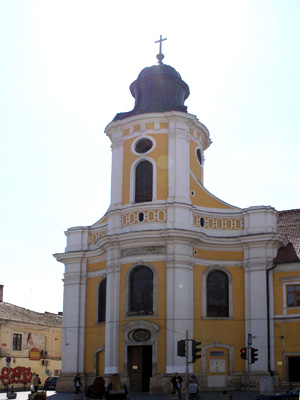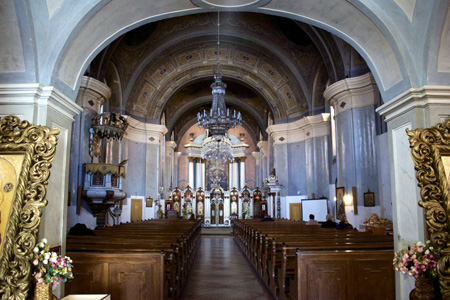| |
 |
 |
 |
| Comment on this report, or find other reports. |
 |
| Our Mystery Worshippers are volunteers who warm church pews for us around the world. If you'd like to become a Mystery Worshipper, start here. |
 |
| Find out how to reproduce this report in your church magazine or website. |
|
|
| 3160: Cathedral of the Transfiguration, Cluj-Napoca, Romania |
 |
 |
 |
Mystery Worshipper: Columba's Currach.
The church: Catedrala Schimbarea la Fațâ (Cathedral of the Transfiguration), Cluj-Napoca, Romania.
Denomination: Romanian Greek Catholic, Eparchy of Cluj-Gherla.
The building: The present building dates from 1778-79 and was partly financed by the Empress Maria Theresa of Austria, who refinanced reconstruction of the tower after it collapsed due to engineering errors. After a fire in 1798, the building was substantially rebuilt. Decorations were added throughout the 19th century. For all of this period, it was a Latin Rite parish under the care of the Order of Friars Minor. In 1924, the Friars relinquished control of the church to Pope Pius IX, who in turn donated the church to the Romanian Greek Catholic Eparchy to serve as their cathedral. I presume the iconostasis was added at this point. In 1948, the government of Romania outlawed the Greek Catholic Church and gave the cathedral in Cluj to the Romanian Orthodox Church, who used it for 50 years, even after the fall of communism. In 1998, after lengthy litigation, the court ruled that it rightfully belonged to the Greek Catholics.
As it now stands, the church is a glorious mixture of the Central European baroque and the Byzantine.
The church: The Romanian Greek Catholic Church is one of the 24 sui juris (autonomous) churches that together comprise the Roman Catholic Church. It dates back to the Hapsburg conquest of Transylvania in the late 17th century. In 1930, the Romanian Catholics were the second-largest religious group in Cluj, just behind the Calvinists and narrowly surpassing the Latin Rite Catholics. Under the communist government, however, the church was made illegal and its membership dwindled. Today, it is mostly concentrated in the far north of Romania, near the Ukrainian border. In Cluj, it is the church of just over four per cent of the population, making it the fourth largest church in the city, after the Orthodox (seventy-one per cent), the Reformed (eleven per cent), and the Latin Rite Catholics (five per cent). Despite the small numbers, the cathedral in Cluj seems to be remarkably active, with several services a day.
The neighbourhood: Cluj-Napoca is the second largest city in Romania and the largest in the historic region of Transylvania. Depending on the date of the text and the ethnicity of its author, you may see it referred to as Kolozsvár (Hungarian), Klausenburg (German), or Kloiznburg (Yiddish). That gives some indication of its complicated history and demography. The Greek Catholic cathedral is located in the city centre, between two other significant churches: the 14th-century church of St Michael (Latin Rite Catholic), and the modern Romanian Orthodox Cathedral of the Dormition of the Theotokos.
The cast: According to the sign outside, the celebrant was the Revd Crişan Viorel Anton. He was assisted by an unnamed man vested in a cassock, whom I assume to have been in minor orders.
The date & time: 25 April 2017, 6.00pm.
What was the name of the service?
Sfânta Liturghie (Holy Liturgy).
How full was the building?
About one-quarter full, with perhaps 60 people. I thought that was pretty impressive for a weekday evening liturgy.
Did anyone welcome you personally?
No.
Was your pew comfortable?
Not particularly. Fortunately it wasn't used very much.
How would you describe the pre-service
atmosphere?
A sound system piped rather incongruous light classical music through the building, including an arrangement of "Greensleeves" for strings. The people were uniformly reverent, but this was expressed in different ways. Some knelt in their pews, others venerated icons along the walls, whilst still others made their confessions (Western-style, in box confessionals).
What were the exact opening words of the
service?
Hristos a înviat! Adevărat a înviat! (Christ is risen! He is risen indeed!). These were also the last words of the service, over an hour later, and some of the few than I recognized.
What books did the congregation use during the
service?
None.
What musical instruments were played?
None. The priest and his assistant chanted their prayers a cappella, as is the custom in Eastern churches. A few of the congregation joined in the responses, but most did not.
Did anything distract you?
Everything distracted me. But perhaps the most curious thing was the bread. Not the bread for the eucharist, but the large pile of plastic-wrapped loaves deposited next to an icon. Periodically, both before and during the service, people would come and add an extra loaf. I saw a similar pile in the Latin Rite Franciscan Church, so it can't have been bread for the artoklasia (bread offered by the faithful in commemoration of the loaves blessed by Christ to feed the multitude). Nor do I think it can have been an offering for the poor. I'm still confused by it.

Was the worship stiff-upper-lip, happy clappy, or
what?
I don't really know how to describe it. It was a Byzantine liturgy celebrated somewhat in the manner of a Western low mass, e.g. without incense or servers. But it was still largely chanted and lasted an hour and fifteen minutes, much longer than any Roman Catholic or Anglican weekday service I've been to!
Exactly how long was the sermon?
7 minutes.
On a scale of 1-10, how good was the preacher?
7 – The priest had a clear rapport with his flock. He spoke expressively, and had something of the warm demeanour I've seen in interviews with Pope Francis and, earlier, Pope St John XXIII. Of course, this could be entirely a case of me (as a northern European) romanticizing the mannerisms of southeastern Europe, as I have no idea what he was saying.
In a nutshell, what was the sermon
about?
No idea, sorry.
Which part of the service was like being in
heaven?
The chanting was often beautiful. But more importantly, it was heavenly to see this community so active at prayer after decades of persecution.
And which part was like being in... er... the other place?
The service was an hour and fifteen minutes long. I didn't understand very much of it, and I was definitely ready for supper by the end. Just when I thought it was over, the priest processed to an icon and led a series of long litanies. If I hadn't been writing this report, I probably would have left early. I know they say that heaven is an eternal liturgy, but they also say that it's a place where "they shall not hunger nor thirst!"
What happened when you hung around after the service looking lost?
Everyone left in a hurry. I presume they were as hungry as I was!
How would you describe the after-service
coffee?
There was none.
How would you feel about making this church your regular (where 10 = ecstatic, 0 = terminal)?
3 – I don't know what I'd do if lived in Cluj. Presumably I'd have to learn more Romanian. If I understood more of the language, I would definitely consider attending this church. Ii's worth pointing out that the Latin Rite churches in Cluj have their liturgies mostly in Hungarian, of which I understand even less.
Did the service make you feel glad to be a
Christian?
Yes.
What one thing will you remember about all this in seven days' time?
The mysterious pile of bread. |
|
|
 |
 |
 |
| We rely on voluntary donations to stay online. If you're a regular visitor to Ship of Fools, please consider supporting us. |
 |
 |
 |
| The Mystery Pilgrim |
 |
| One of our most seasoned reporters makes the Camino pilgrimage to Santiago de Compostela in Spain. Read here. |
 |
 |
 |
| London churches |
 |
| Read reports from 70 London churches, visited by a small army of Mystery Worshippers on one single Sunday. Read here. |
| |
|
|
|
|


